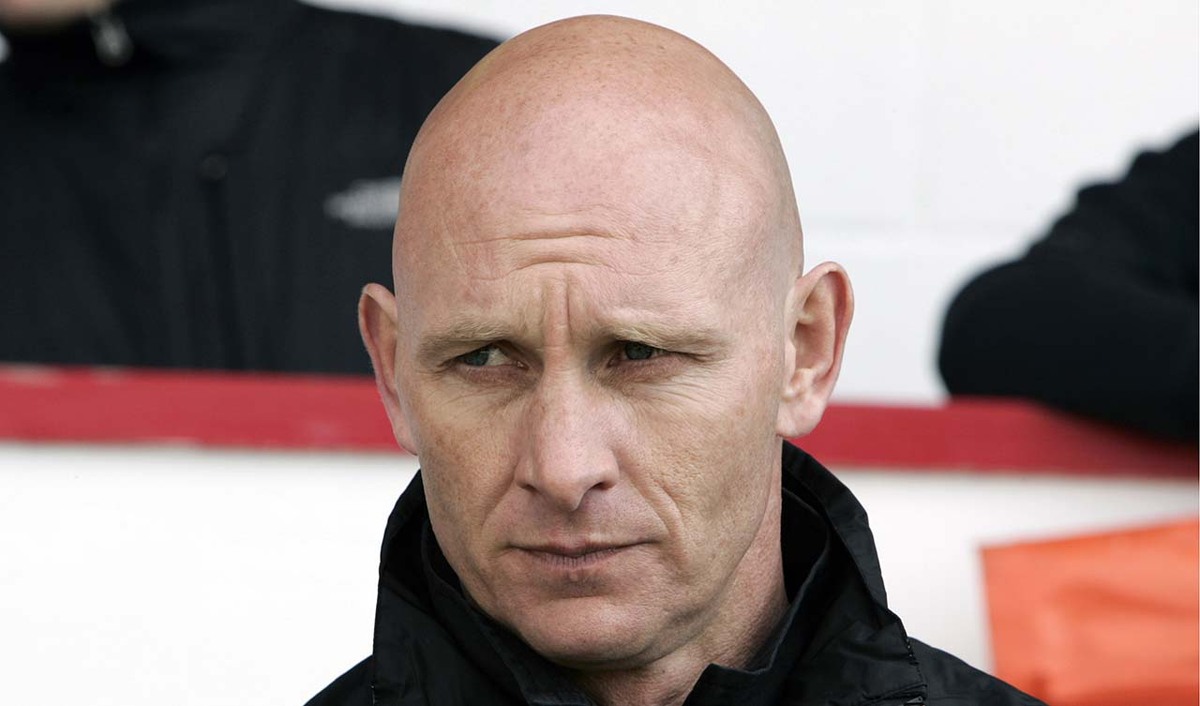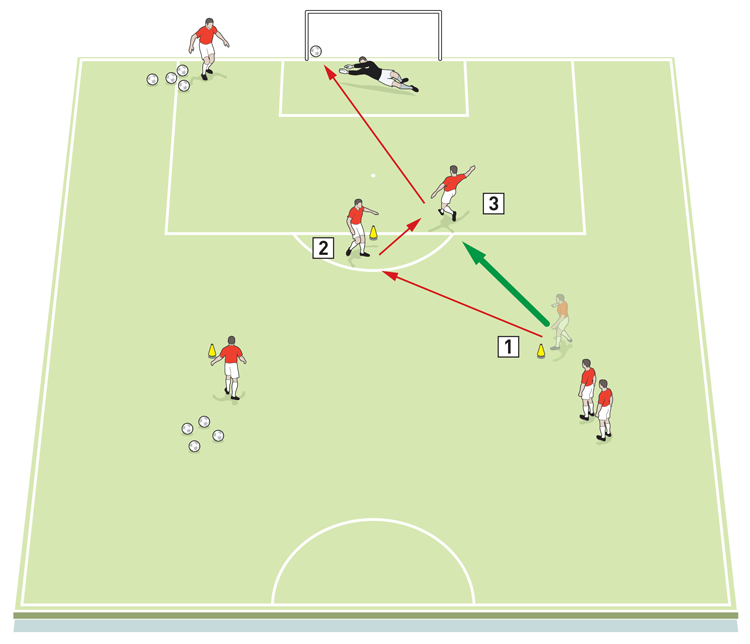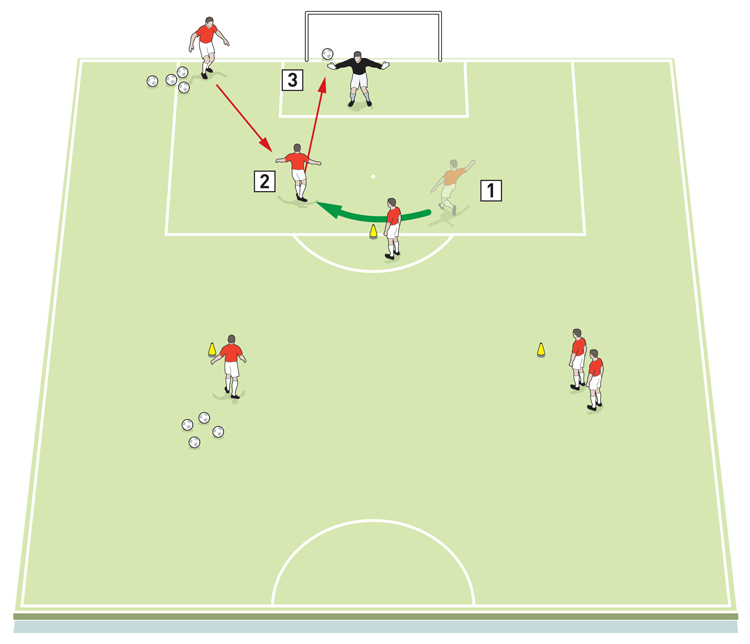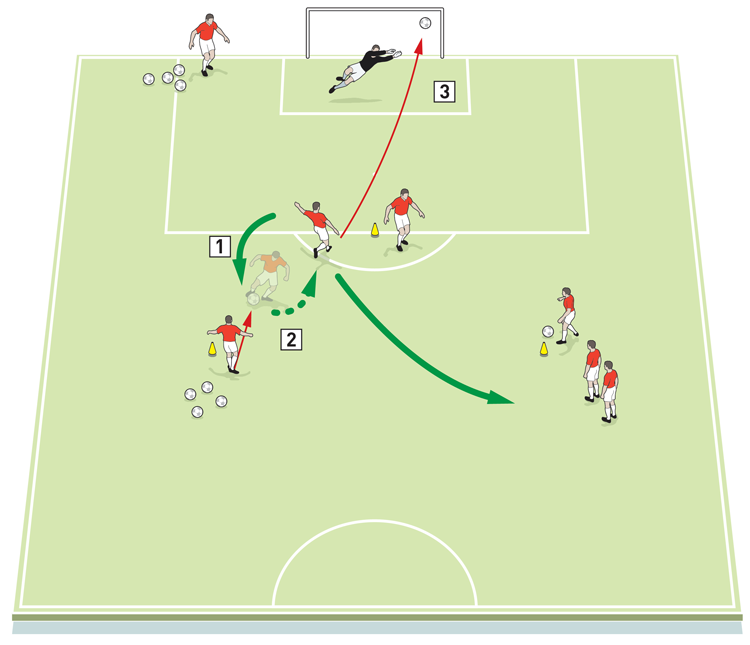Shooting in and around the box
This session is about shooting from different angles in and around the box. It looks at how players can best negotiate space in what is the tightest, most controlled area of the pitch, while also explaining the benefits of reacting after each shot.

| Area | Half-pitch |
| Equipment | Balls, cones, goals |
| No. of Players | 6/7 outfield plus a keeper |
| Session Time | 20mins left side, 20mins right side |
This session is about shooting from different angles in and around the box. It looks at how players can best negotiate space in what is the tightest, most controlled area of the pitch, while also explaining the benefits of reacting after each shot and using different techniques in order to get the most impactful effort on goal (such as side-foot efforts, using the laces, volleys and more). It also looks at left- and right-sided play so that in match situations players are comfortable shooting with either foot, accepting that some make need to spend more time practising on a weaker side.
We will typically run this session at least once a week – it’s perfect for getting players’ technical shooting qualities up, and because there is a goalscoring reward at the end, it’s the kind of practice that they will naturally enjoy.
What do I get the players to do?
We set up as shown using 6-12 balls and 6-8 players. The attacking practice uses players on fixed stations with one working player (player 1) who links with each in producing what amounts to four very different types of shots on goal (1a/1b/1c).
1a

2. Player 2 receives the ball then lays it off
3. Player 1 approaches and shoots first-time
1b

2. He now receives a pass from player 3 – this can be either as a pass on the floor, a volley or a header
3. One-touch, he must finish from this set-up
1c

2. He receives a pass from player 4. He turns back towards goal with the ball
3. Player 1 now finishes from outside the box
After player 1 has completed his movement in and around the box, he assumes the position of player 2 in order to become the target player. Other numbered players rotate in their positions to the next station with player 4 moving to the back of the line of players behind player 1.
Once every player has performed the necessary task, we will set up the drill on the other side of the pitch to include the variation that sees players tested on both feet.
What are the key things to look out for?
This session is largely about the final shot, but to get that right we need players able to get their body shape correct in order to approach and attack different types of set-up. This means we want to see them thinking about how they will need to receive a ball before they reach the next station, anticipating its flight and knowing in their minds how they are going to take on the shot long before it arrives at their feet.
Moving on, as soon as that shot has been despatched, we want to see positive, intentional movement to the next station and that onward thought process extended into the next shot.
We must also be alert in eliminating the typical mistakes that attackers make, most of which result in the ball missing the target. These include not looking at the ball when shooting, not having the head over the ball (i.e. leaning back), trying to hit a shot too hard, and approaching the ball with an unnatural body shape that impairs control and impact.
How do I progress the session?
There are a few things we can do in order to enhance the pressure and intensity of this session and this comes in the form of three key elements – speed, accuracy and technique.
Firstly, we can time players to see if they can perform the moves within 25-, 20- and 15-second timeframes. The benefit of doing this is so that shooting becomes more instinctive – they cannot dwell over shots (just as they wouldn’t be able to in a real game), and must act with a level of urgency that also means after getting the shot away they are moving into the next phase straight away.
Having worked on speed we can look to improve accuracy by instructing players to aim for the corners of the goal when shooting. While we may see more shots going wide there should be an equal number that fully challenge the keeper, therefore making this practice more engaging for him as well.
And finally, in terms of technique, we can set up certain types of shots on each run. For instance, all volleys, all two-touch, or perhaps all chested down for a finish. Forcing technique onto players is the best method for them improving.
Editor's Picks
Attacking transitions
Deep runs in the final third
Using the goalkeeper in build-up play
Intensive boxes drill with goals
Penetrating the final third
Creating and finishing
My philosophy
Pressing initiation
Compact team movement
Coaches' Testimonials

Alan Pardew

Arsène Wenger

Brendan Rodgers

Carlos Carvalhal

José Mourinho

Jürgen Klopp

Pep Guardiola

Roy Hodgson

Sir Alex Ferguson

Steven Gerrard
Coaches' Testimonials

Gerald Kearney, Downtown Las Vegas Soccer Club

Paul Butler, Florida, USA

Rick Shields, Springboro, USA

Tony Green, Pierrefonds Titans, Quebec, Canada
Join the world's leading coaches and managers and discover for yourself one of the best kept secrets in coaching. No other training tool on the planet is written or read by the calibre of names you’ll find in Elite Soccer.
In a recent survey 92% of subscribers said Elite Soccer makes them more confident, 89% said it makes them a more effective coach and 91% said it makes them more inspired.
Get Monthly Inspiration
All the latest techniques and approaches
Since 2010 Elite Soccer has given subscribers exclusive insight into the training ground practices of the world’s best coaches. Published in partnership with the League Managers Association we have unparalleled access to the leading lights in the English leagues, as well as a host of international managers.
Elite Soccer exclusively features sessions written by the coaches themselves. There are no observed sessions and no sessions “in the style of”, just first-hand advice delivered direct to you from the coach.









